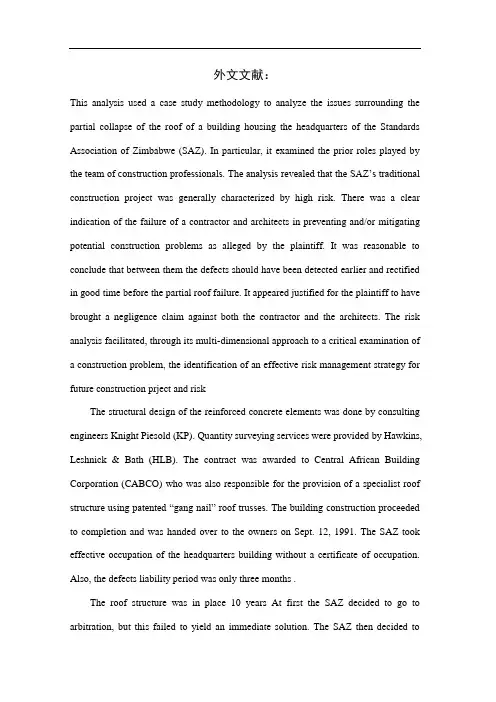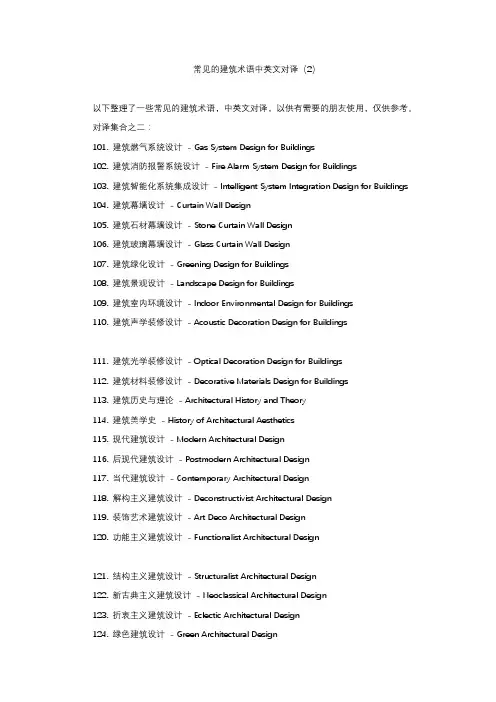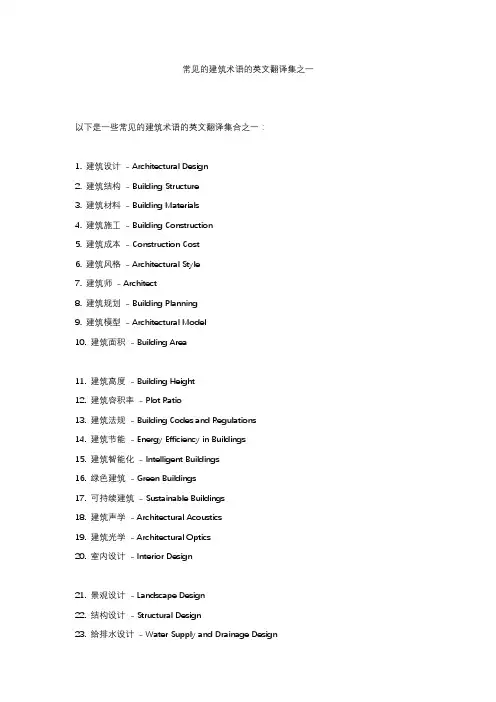商业建筑外文文献翻译)
外文翻译外文文献英文文献国际建设工程风险分析

外文文献:This analysis used a case study methodology to analyze the issues surrounding the partial collapse of the roof of a building housing the headquarters of the Standards Association of Zimbabwe (SAZ). In particular, it examined the prior roles played by the team of construction professionals. The analysis revealed that the SAZ’s traditional construction project was generally characterized by high risk. There was a clear indication of the failure of a contractor and architects in preventing and/or mitigating potential construction problems as alleged by the plaintiff. It was reasonable to conclude that between them the defects should have been detected earlier and rectified in good time before the partial roof failure. It appeared justified for the plaintiff to have brought a negligence claim against both the contractor and the architects. The risk analysis facilitated, through its multi-dimensional approach to a critical examination of a construction problem, the identification of an effective risk management strategy for future construction prject and riskThe structural design of the reinforced concrete elements was done by consulting engineers Knight Piesold (KP). Quantity surveying services were provided by Hawkins, Leshnick & Bath (HLB). The contract was awarded to Central African Building Corporation (CABCO) who was also responsible for the provision of a specialist roof structure using patented “gang nail” roof trusses. The building construction proceeded to completion and was handed over to the owners on Sept. 12, 1991. The SAZ took effective occupation of the headquarters building without a certificate of occupation. Also, the defects liability period was only three months .The roof structure was in place 10 years At first the SAZ decided to go to arbitration, but this failed to yield an immediate solution. The SAZ then decided toproceed to litigate in court and to bring a negligence claim against CABCO. The preparation for arbitration was reused for litigation. The SAZ’s quantified losses stood at approximately $ 6 million in Zimbabwe dollars (US $1.2m) .After all parties had examined the facts and evidence before them, it became clear that there was a great probability that the courts might rule that both the architects and the contractor were lia ble. It was at this stage that the defendants’ lawyers requested that the matter be settled out of court. The plaintiff agreed to this suxamined the prior roles played by the project management function and construction professionals in preventing/mitigating potential construction problems. It further assessed the extent to which the employer/client and parties to a construction contract are able to recover damages under that contract. The main objective of this critical analysis was to identify an effective risk management strategy for future construction projects. The importance of this study is its multidimensional examination approach.Experience sugge be misleading. All construction projects are prototypes to some extent and imply change. Change in the construction industry itself suggests that past experience is unlikely to be sufficient on its own. A structured approach is required. Such a structure can not and must not replace the experience and expertise of the participant. Rather, it brings additional benefits that assist to clarify objectives, identify the nature of the uncertainties, introduces effective communication systems, improves decision-making, introduces effective risk control measures, protects the project objectives and provides knowledge of the risk history .Construction professionals need to know how to balance the contingencies of risk with their specific contractual, financial, operational and organizational requirements. Many construction professionals look at risks in dividually with a myopic lens and donot realize the potential impact that other associated risks may have on their business operations. Using a holistic risk management approach will enable a firm to identify all of the organization’s business risks. This will increas e the probability of risk mitigation, with the ultimate goal of total risk elimination .Recommended key construction and risk management strategies for future construction projects have been considered and their explanation follows. J.W. Hinchey stated th at there is and can be no ‘best practice’ standard for risk allocation on a high-profile project or for that matter, any project. He said, instead, successful risk management is a mind-set and a process. According to Hinchey, the ideal mind-set is for the parties and their representatives to, first, be intentional about identifying project risks and then to proceed to develop a systematic and comprehensive process for avoiding, mitigat and its location. This is said to be necessary not only to allow alternative responses to be explored. But also to ensure that the right questions are asked and the major risks identified. Heads of sources of risk are said to be a convenient way of providing a structure for identifying risks to completion of a participant’s pa rt of the project. Effective risk management is said to require a multi-disciplinary approach. Inevitably risk management requires examination of engineering, legal and insurance related solutions .It is stated that the use of analytical techniques based on a statistical approach could be of enormous use in decision making . Many of these techniques are said to be relevant to estimation of the consequences of risk events, and not how allocation of risk is to be achieved. In addition, at the present stage of the development of risk management, Atkinson states that it must be recognized that major decisions will be made that can not be based solely on mathematical analysis. The complexity ofconstruction projects means that the project definition in terms of both physical form and organizational structure will be based on consideration of only a relatively small number of risks . This is said to then allow a general structured approach that can be applied to any construction project to increase the awareness of participants .The new, simplified Construction Design and Management Regulations (CDM Regulations) which came in to f 1996, into a single regulatory package.The new CDM regulations offer an opportunity for a step change in health and safety performance and are used to reemphasize the health, safety and broader business benefits of a well-managed and co-ordinated approach to the management of health and safety in construction. I believe that the development of these skills is imperative to provide the client with the most effective services available, delivering the best value project possible.Construction Management at Risk (CM at Risk), similar to established private sector methods of construction contracting, is gaining popularity in the public sector. It is a process that allows a client to select a construction manager (CM) based on qualifications; make the CM a member of a collaborative project team; centralize responsibility for construction under a single contract; obtain a bonded guaranteed maximum price; produce a more manageable, predictable project; save time and money; and reduce risk for the client, the architect and the CM.CM at Risk, a more professional approach to construction, is taking its place along with design-build, bridging and the more traditional process of design-bid-build as an established method of project delivery.The AE can review to get the projec. Competition in the community is more equitable: all subcontractors have a fair shot at the work .A contingency within the GMP covers unexpected but justifiable costs, and a contingency above the GMP allows for client changes. As long as the subcontractors are within the GMP they are reimbursed to the CM, so the CM represents the client in negotiating inevitable changes with subcontractors.There can be similar problems where each party in a project is separately insured. For this reason a move towards project insurance is recommended. The traditional approach reinforces adversarial attitudes, and even provides incentives for people to overlook or conceal risks in an attempt to avoid or transfer responsibility.A contingency within the GMP covers unexpected but justifiable costs, and a contingency above the GMP allows for client changes. As long as the subcontractors are within the GMP they are reimbursed to the CM, so the CM represents the client in negotiating inevitable changes with subcontractors.There can be similar problems where each party in a project is separately insured. For this reason a move towards project insurance is recommended. The traditional approach reinforces adversarial attitudes, and even provides incentives for people to overlook or conceal risks in an attempt to avoid or transfer responsibility.It was reasonable to assume that between them the defects should have been detected earlier and rectified in good time before the partial roof failure. It did appear justified for the plaintiff to have brought a negligence claim against both the contractor and the architects.In many projects clients do not understand the importance of their role in facilitating cooperation and coordination; the desi recompense. They do not want surprises, and are more likely to engage in litigation when things go wrong.中文译文:国际建设工程风险分析索赔看来是合乎情理的。
浙江大学本科毕业论文外文文献翻译

核准通过,归档资料。
未经允许,请勿外传!浙江大学本科毕业论文外文文献翻译The influence of political connections on the firm value of small and medium-sized enterprises in China政治关联在中国对中小型企业价值的影响1摘要中小型企业的价值受很多因素的影响,比如股东、现金流以及政治关联等.这篇文章调查的正是在中国政治关联对中小型企业价值的影响。
通过实验数据来分析政治关联对企业价值效益的影响.结果表明政府关联是关键的因素并且在中国对中小型企业的价值具有负面影响。
2重要内容翻译2。
1引言在商业界,有越来越多关于政治关联的影响的经济研究。
它们发现政治关联能够帮助企业确保有利的规章条件以及成功获得资源,比如能够最终提高企业价值或是提升绩效的银行贷款,这种政治关联的影响在不同的经济条件下呈现不同的效果。
在高腐败和法律制度薄弱的国家,政治关联对企业价值具有决定性因素1的作用.中国由高度集权的计划经济向市场经济转变,政府对市场具有较强的控制作用,而且有大量的上市企业具有政治关联。
中小型企业发展的很迅速,他们已经在全球经济环境中变得越来越重要。
从90年代起, 政治因素对中国的任何规模的企业来说都变得越来越重要,尤其是中小型企业的价值。
和其他的部门相比较,中小型企业只有较小的现金流,不稳定的现金流且高负债率.一方面,中小型企业改变更加灵活;另一方面,中小型企业在由于企业规模以及对银行来说没有可以抵押的资产,在筹资方面较为困难。
企业如何应对微观经济环境和政策去保证正常的企业活动,并且政治关联如何影响企业价值?这篇论文调查政治关联和企业价值之间的联系,并且试图去研究企业是否可以从政治关联中获利提升企业价值。
2.2定义这些中小型企业之所以叫中小型企业,是和管理规模有关。
对这些小企业来说,雇员很少,营业额较低,资金一般由较少的人提供,因此,通常由这些业主直接管理企业。
中英文建筑术语翻译2

常见的建筑术语中英文对译(2)以下整理了一些常见的建筑术语,中英文对译,以供有需要的朋友使用,仅供参考。
对译集合之二:101. 建筑燃气系统设计- Gas System Design for Buildings102. 建筑消防报警系统设计- Fire Alarm System Design for Buildings103. 建筑智能化系统集成设计- Intelligent System Integration Design for Buildings 104. 建筑幕墙设计- Curtain Wall Design105. 建筑石材幕墙设计- Stone Curtain Wall Design106. 建筑玻璃幕墙设计- Glass Curtain Wall Design107. 建筑绿化设计- Greening Design for Buildings108. 建筑景观设计- Landscape Design for Buildings109. 建筑室内环境设计- Indoor Environmental Design for Buildings110. 建筑声学装修设计- Acoustic Decoration Design for Buildings111. 建筑光学装修设计- Optical Decoration Design for Buildings112. 建筑材料装修设计- Decorative Materials Design for Buildings113. 建筑历史与理论- Architectural History and Theory114. 建筑美学史- History of Architectural Aesthetics115. 现代建筑设计- Modern Architectural Design116. 后现代建筑设计- Postmodern Architectural Design117. 当代建筑设计- Contemporary Architectural Design118. 解构主义建筑设计- Deconstructivist Architectural Design119. 装饰艺术建筑设计- Art Deco Architectural Design120. 功能主义建筑设计- Functionalist Architectural Design121. 结构主义建筑设计- Structuralist Architectural Design122. 新古典主义建筑设计- Neoclassical Architectural Design123. 折衷主义建筑设计- Eclectic Architectural Design124. 绿色建筑设计- Green Architectural Design125. 人文主义建筑设计- Humanist Architectural Design126. 新地域主义建筑设计- New Regionalist Architectural Design 127. 参数化建筑设计- Parametric Architectural Design128. 数字建筑设计- Digital Architectural Design129. 未来主义建筑设计- Futurist Architectural Design130. 智能化建筑设计- Intelligent Building Design131. 生态建筑设计- Ecological Architectural Design132. 城市设计- Urban Design133. 景观设计- Landscape Design134. 城市规划- Urban Planning135. 城市更新- Urban Renewal136. 城市改造- Urban Transformation137. 城市意象- Urban Image138. 城市设计理论- Urban Design Theory139. 城市生态设计- Urban Ecological Design140. 城市交通设计- Urban Transportation Design141. 城市基础设施设计- Urban Infrastructure Design142. 城市天际线设计- Urban Skyline Design143. 城市夜景设计- Urban Nightscape Design144. 城市滨水区设计- Urban Waterfront Design145. 城市开放空间设计- Urban Open Space Design146. 城市街道景观设计- Urban Streetscape Design147. 城市公园设计- Urban Park Design148. 城市居住区设计- Urban Residential District Design149. 城市商业区设计- Urban Commercial District Design150. 城市文化区设计- Urban Cultural District Design151. 城市行政中心设计- Urban Governmental District Design152. 城市会展中心设计- Urban Exhibition and Convention Center Design 153. 城市体育馆设计- Urban Stadium Design154. 城市图书馆设计- Urban Library Design155. 城市博物馆设计- Urban Museum Design156. 城市大剧院设计- Urban Theater Design157. 城市机场设计- Urban Airport Design158. 城市火车站设计- Urban Train Station Design159. 城市地铁站设计- Urban Subway Station Design160. 城市公交车站设计- Urban Bus Stop Design161. 城市景观照明设计- Urban Landscape Lighting Design162. 城市标识系统设计- Urban Signage System Design163. 城市公共艺术装置设计- Public Art Installation Design164. 城市家具设计- Urban Furniture Design165. 城市花坛设计- Urban Flower Bed Design166. 城市儿童游乐设施设计- Urban Playground Design167. 城市植栽设计- Urban Planting Design168. 城市排水系统设计- Urban Drainage System Design169. 城市防洪系统设计- Urban Flood Control System Design170. 城市消防系统设计- Urban Fire Protection System Design171. 城市应急救援系统设计- Urban Emergency Rescue System Design 172. 城市废弃物处理系统设计- Urban Waste Management System Design 173. 城市给水系统设计- Urban Water Supply System Design174. 城市污水处理系统设计- Urban Wastewater Treatment System Design 175. 城市雨水排放系统设计- Urban Stormwater Management System Design 176. 城市空调系统设计- Urban Air Conditioning System Design177. 城市供暖系统设计- Urban Heating System Design178. 城市燃气供应系统设计- Urban Gas Supply System Design179. 城市电力供应系统设计- Urban Electrical Power Supply System Design180. 城市智能化管理系统设计- Urban Intelligent Management System Design 181. 城市绿色建筑认证体系- Green Building Certification Systems182. 城市绿色建筑评价体系- Green Building Evaluation Systems183. 可持续城市发展理论- Sustainable Urban Development Theory184. 生态城市理论- Eco-city Theory185. 低碳城市理论- Low-carbon City Theory186. 紧凑城市理论- Compact City Theory187. 智慧城市理论- Smart City Theory188. 韧性城市理论- Resilient City Theory189. 多规合一城市规划体系- Integrated Urban Planning System190. 城市设计哲学- Urban Design Philosophy191. 城市设计心理学- Urban Design Psychology192. 城市设计社会学- Urban Design Sociology193. 城市设计地理学- Urban Design Geography194. 城市设计经济学- Urban Design Economics195. 城市设计生态学- Urban Design Ecology196. 城市设计符号学- Urban Design Semiotics197. 城市设计现象学- Urban Design Phenomenology198. 城市设计未来学- Urban Design Futures Studies199. 城市设计艺术史- Urban Design Art History200. 城市设计与公共政策- Urban Design and Public Policy待续。
ArchitectureEnglish-2 建筑英语第二单元

epitomize : v. 概括; 成为 ... 的缩影; 作为典范
Ajanta Cave & Katsura Detached Palace
课文翻译 Paragraph5-1
The Teotihuacan culture of Mexico contained two immense pyramids embedded in what was a vast city. The Mayan civilization’s greatest building periods fall within the 4th to the 11th century. The Maya created impressive structures through extensive earth moving. Their bold architectural sculpture is either integral with the stone monuments or is added as stucco ornamentation. 墨西哥提奥帝华坎文化(公 元前100年到公元700年)拥有 两座巨型金字塔镶嵌于一座庞 大的城市当中。玛雅文明最伟 大的建筑时期是公元4世纪到公 元11世纪。通过大范围的迁徙 途中,玛雅人创造出了许多令 人印象深刻的建筑物。他们粗 犷的建筑雕刻中既有整体岩石 雕琢也有涂以灰泥为装饰。
Statue of Athena Promachos Propylaea
终产物;习惯用法仅指具有文
化重要性的设计和结构。建筑 必须要满足其使用目的,必须
技术上可靠,而且必须传达美
学意义。一些最为杰出的建筑 物通常修建巧妙,以至于已经
超出了其最初的使用目的,不
一般建筑术语英文翻译之一

常见的建筑术语的英文翻译集之一以下是一些常见的建筑术语的英文翻译集合之一:1. 建筑设计- Architectural Design2. 建筑结构- Building Structure3. 建筑材料- Building Materials4. 建筑施工- Building Construction5. 建筑成本- Construction Cost6. 建筑风格- Architectural Style7. 建筑师- Architect8. 建筑规划- Building Planning9. 建筑模型- Architectural Model10. 建筑面积- Building Area11. 建筑高度- Building Height12. 建筑容积率- Plot Ratio13. 建筑法规- Building Codes and Regulations14. 建筑节能- Energy Efficiency in Buildings15. 建筑智能化- Intelligent Buildings16. 绿色建筑- Green Buildings17. 可持续建筑- Sustainable Buildings18. 建筑声学- Architectural Acoustics19. 建筑光学- Architectural Optics20. 室内设计- Interior Design21. 景观设计- Landscape Design22. 结构设计- Structural Design23. 给排水设计- Water Supply and Drainage Design24. 暖通空调设计- HVAC Design25. 电气设计- Electrical Design26. 消防设计- Fire Protection Design27. 智能化系统设计- Intelligent System Design28. 施工组织设计- Construction Organization Design29. 施工图设计- Construction Drawing Design30. 装饰装修设计- Decoration and Finishing Design31. 建筑声学设计- Architectural Acoustics Design32. 建筑光学设计- Architectural Optics Design33. 建筑热工设计- Architectural Thermal Design34. 建筑美学设计- Architectural Aesthetic Design35. 建筑环境设计- Architectural Environment Design36. 建筑风水学- Feng Shui37. 建筑日照分析- Solar Analysis for Buildings38. 建筑通风分析- Ventilation Analysis for Buildings39. 建筑声环境分析- Acoustic Environment Analysis for Buildings40. 建筑光环境分析- Daylighting Environment Analysis for Buildings41. 建筑热环境分析- Thermal Environment Analysis for Buildings42. 建筑面积计算- Building Area Calculation43. 建筑楼层高度- Storey Height44. 建筑消防设计- Fire Protection Design for Buildings45. 建筑结构安全评估- Structural Safety Evaluation for Buildings46. 建筑抗震设计- Seismic Design for Buildings47. 建筑防洪设计- Flood-resistant Design for Buildings48. 建筑工程招标- Building Engineering Tendering49. 建筑工程施工许可- Construction Permission for Building Projects50. 建筑工程造价咨询- Engineering Cost Consulting for Building Projects51. 建筑工程监理- Project Supervision for Building Projects52. 建筑工程验收- Acceptance of Building Projects53. 建筑工程质量检测- Quality Detection of Building Projects54. 建筑工程质量评估- Quality Evaluation of Building Projects55. 建筑工程质量保修- Quality Guarantee of Building Projects56. 建筑工程档案- Construction Project Archives57. 建筑工程安全- Construction Safety58. 建筑工程管理- Construction Project Management59. 建筑工程合同- Construction Contract60. 建筑工程保险- Construction Insurance61. 建筑工程材料- Construction Materials62. 建筑工程机械- Construction Machinery63. 建筑工程劳务- Construction Labor64. 建筑工程施工组织设计- Construction Organization Design for Building Projects65. 建筑工程施工图设计- Construction Drawing Design for Building Projects66. 建筑工程施工进度计划- Construction Progress Plan for Building Projects67. 建筑工程施工质量控制- Construction Quality Control for Building Projects68. 建筑工程施工安全管理- Construction Safety Management for Building Projects69. 建筑工程施工现场管理- Construction Site Management for Building Projects70. 建筑工程施工成本管理- Construction Cost Management for Building Projects71. 建筑工程施工环境保护- Environmental Protection in Building Construction72. 建筑工程施工节能管理- Energy-saving Management in Building Construction73. 建筑工程施工水土保持- Soil and Water Conservation in Building Construction74. 建筑工程施工质量控制要点- Key Points of Construction Quality Control for Building Projects75. 建筑工程施工安全控制要点- Key Points of Construction Safety Control for Building Projects76. 建筑工程施工质量验收规范- Acceptance Specification for Construction Quality ofBuilding Projects77. 建筑立面设计- Façade Design78. 建筑剖面设计- Section Design79. 建筑立面分析图- Façade Analysis Diagram80. 建筑剖面分析图- Section Analysis Diagram81. 建筑结构分析图- Structural Analysis Diagram82. 建筑平面图- Floor Plan83. 建筑立面图- Façade Drawing84. 建筑剖面图- Section Drawing85. 建筑轴测图- Axonometric Drawing86. 建筑渲染图- Architectural Rendering87. 建筑模型制作- Model Making88. 建筑绘画- Architectural Drawing89. 建筑表现图- Architectural Representation90. 建筑动画- Architectural Animation91. 建筑摄影- Architectural Photography92. 建筑信息模型- Building Information Modeling (BIM)93. 建筑环境评估- Building Environmental Assessment94. 建筑节能评估- Building Energy Efficiency Assessment95. 建筑可持续性评估- Building Sustainability Assessment96. 建筑健康评估- Building Health Assessment97. 建筑设备系统设计- Building Equipment System Design98. 建筑电气系统设计- Electrical System Design for Buildings99. 建筑给排水系统设计- Water Supply and Drainage System Design for Buildings 100. 建筑暖通空调系统设计- HVAC System Design for Buildings。
商业建筑外文翻译 文档

上海一个可持续发展的商业建筑的生命周期评估王楠楠昌尹强克里斯·纳恩摘要:建筑是一种在它整个生命周期中具有长期巨大环境影响的产物,建筑物的设计要考虑到长期的环境和经济效益。
一个生命周期评价法将在一个上海旗舰店的战略设计中所展现,工业从业人员应邀参加了可行性研究,他们的意见被包括在生命周期评价还是第一次。
经济分析不仅要考虑方案设计成本,也要考虑在建设的运行成本。
采用的方法是一个完整的生命周期评价过程,包括寿命周期成本、多准则决策和群决策方法。
这个研究会在给从业人员提供教学机会方面做的很成功并取得了良好的反馈。
在生命周期评价过程被从业人员选用后,十大可持续设计方案被作为义务的设计策略在其全球环境发展议程。
这生命周期评估工具通过一个案例证明了它是简单和有效的设计实践工具,因此它可以应用于其他项目,协助决策者。
关键词:生命周期评价可持续发展建筑多准则决策群体决策可持续发展简介:目前共有约400亿平方米的建筑物在中国,这个数字在2020年将达到700亿[1]。
建筑业已对环境产生重大影响。
与建筑有关的能源消耗,例如:建筑建造和施工,占中国每年近50%的总能量[1]。
在中国每年有约650万公吨是由建设产生的浪费[2]。
可持续建筑设计在中国建筑行业已经是一个紧迫的任务。
可持续发展的建筑设计减少了在建筑物的整个生命周期中人为因素对环境产生的影响。
更至关重要的是投资者考虑到建筑物对环境的影响是通过其整个生命周期,从最初的建设过程到对今后运营的阶段。
在不同的国家有各种各样的可持续利用评价工具,。
BRE的环境评估方法(BREEAM)系统是一个综合的可持续发展评估工具,被用在英国。
这个工具包括废物、水和能源,也包括包括建筑所占用的运输、污染、社会参与、健康与福祉,材料的选择提高生物多样性和建筑管理。
这个BREEAM系列可评估的几种不同类型的建筑设计,包括法院、医疗、工业、国际,多层住宅、监狱、办公、零售、教育和社区。
专业课程科目名称法语翻译
专业课程科目名称法语翻译计算机室内设计designintérieurinformatique外国美术史histoireartistiquedespaysétrangers商业环境设计designdansl’environnementcommercial公共建筑室内设计designintérieurdel’édificationpublique 社会实践 pratiquessociales中国传统室内设计designintérieurtraditionnelchino is命题设计designdeterminé外出考察 investigationsortie园林设计 designjardinier毕业论文thèse/mémoiredefind’études绘画透视Scénographiedudessin书法 Calligraphie图案 Motif计算机 Informatique美术概论Traitédesbeaux-arts自描 Auto-portrait构成 Composition油画风景Paysagesdepeintureàl’huile创作Techniquedecréation油画材料Matérieldepeintureàl’huile油画静物naturemortedanslapeintureàl’huile油画肖像Portraitdanslapeintureàl’huile山水 Peinturedepaysage工笔花鸟 Peinturechinoisedefactureminutieuseetpeinturedefleursetoiseaux 材料技法Technologiedematériels中国美术史Histoiredesbeaux-artschinois外国美术史Histoiredesbeaux-artsétranger丝网印刷 Impressiondefiletetdefil书籍装帧Présentationdeslivres美术教育 Educationdesbeaux-arts招贴设计Designd’affiche电脑美术 Beaux-artsinformatique教育学论文Thèsesdesciencedel’éducation心理学论文Thèsesdepsychologie转贴于:小语种考试_考试大平面设计平面构成 structurationplane色彩设计计划 projetdedesigndecouleur立体构成structurationstéréoscopique 装饰图案鉴赏appréciationdedessindécoratif 图形想象与思维imaginationetpenséefigu ratives 基础摄影 photographiefondamentale计算机辅助 assistanceinformatique人机工程学érgonomie机械制图dessinmécanique机构形象设计 Designdeportraitadministratif 印刷工艺technologieimprimée创意招贴affichecréative包装设计designd’emb allage建筑装饰画法几何géométriededessin阴影透视scénographiedel’ombre建筑制图 dessindeconstruction大学基础英语 anglaisfondamataluniversitaire 计算机基础basesdel’inforamatique素描 dessin色彩 coloris政治经济学scienceséconomiquesetpoliti ques哲学 pholosophie建筑绘图 dessinantconstructeur三大构成 troisgrandescompositions建筑装饰材料matériauxdedécorationconstructrice建筑装饰施工travauxdedécorationconstructrice建筑装饰设备équipementdedécorationconstructrice建筑装饰概预算estimationbudgétairededécorationconstructrice 中国建筑史 histoiredelaconstructionchinoise建筑概论introductionàlaconstruction建筑规划 planificationconstructrice室内外装饰décorationintérieureetextérieure应用文写作 compositionpratique毕业设计projetdefind’études毕业设计答辩réponseduprojetdefind’études英语专业英语泛读Lecturegénéraleenanglais英语会话 Conversationenanglais英语语音Phonétiqueanglaise综合英语Anglaissynthétique英语口语 Anglaisoral英语听说 Anglaisaudio-visuel基础视听 Anglaisaudio-visuel(élémentaire)旅游英语 Anglaistouristique英美概况Connaissancesgénéralesdel’AngleterreetdesEtats-Unis英语语法 Grammaireanglaise英语写作Techniqued’écritureenanglais英语阅读 Lectureenanglais外贸英语Anglaisducommerceextérieur高级视听 Anglaisaudio-visuel(avancé)高级英语Anglaisavancé简明英语语言学Brèvedelalin guistiqueanglaise外报外刊Journauxetrevusétrangers英国文学作品选 Oeuvreschoisiesanglo-saxonnes世界政治经济与国际关系Economieetpolitiquemondialesetrelationsinternationales英语报刊选读 LecturechoisiedesjournauxanglaisWTO概论IntroductionàWTO第二外语Deuxièmelangueétrangère高级英语写作Techniqued’écritureenanglais(avancé)教育实习Stagedel’enseignement英译汉 Version(外文译成本国文)汉译英Thème(本国文译成外文)英美文学作品选读 Oeuvreschoisiesanglo-américaines英美教学理论Théoriepédagogiqueanglo-américaine英语口译Interprétationenanglais圣经与罗马神话Bibleetlégendesromaines英美影视欣赏Appréciationdesoeuvrescénimatographiquesettélévisuelle sanglo-américaines英语词汇学 Lexicologieanglaise写作基础Techniquesélémentairesd’écriture enanglais英语写作与修辞Ecritureetrhétoriqueenanglais英语短篇小说阅读 Lecturedesnouvellesenanglais英国文化 Cultureanglo-saxonne生命科学导论Introductionàlasciencedelavie海洋生物学 Biologiemaritime公关礼仪 Protocolespubliques文学阅读导论Introductionàlalecturelittéraire阅读与欣赏Lectureetappréciation高级商务英语Anglaisavancéducommerce英语八级考试辅导Coursréparatoiresàl’examend’anglaisdedegré8欧洲文学史Histoirelittéraireeuropéenne快速阅读 Lecturerapide英语应用文写作 Ecrtiturepratiqueenanglais广告英语 Anglaispublicitaire英语专业八级Degré8del’anglaisspecialize。
文献翻译-Loma Prieta地震
附件D:本科学生毕业设计外文译文指导教师评语:指导教师评定成绩签字:交叉评阅教师评语:教务处译文1989年10月17日,Loma Prieta地震1989年10月商业结构Loma Prieta地震和它的余震导致了一系列商业结构的大面积顺坏损坏.正如这个量级的典型地震一样,有一大批地理范围受到了影响.被波及的地区包括8个郡,从南部的Monterey和San Benito,到北部的San Francisco, Alameda, 和Contra Costa .总共有大约3000平方英里面积的建筑结构遭受到了破坏.尽管地震带来的破坏面积很广,但是这些破坏很零散.据估计,最接近震中的地区,包括Hollister, Los Gatos, Santa Cruz, 和 Watsonville 经历了最集中的破坏.再远一点,仅仅是那些地基建在松软的土质上的质量非常差的建筑物遭到了严重的破坏,这些土质在地震的运动中中被破坏和坍塌.这和1985年的墨西哥地震产生的影响是相似的.地震的影响是具有很强的方向性的.大多数破坏发生在从西北向东南方向延伸的狭窄地段,大约与San Andreas Fault平行.因此沿着 San Francisco 湾的许多地区逃脱了这场截难.不稳固的石质建筑物正如在过去的California 地震中所发现的那样,最集中和严重的建筑物结构破坏发生在不稳固的石质建筑物结构中.不稳固的石质建筑物结构包括木头框架的屋顶和地板,这些屋顶和地板是由很厚的不稳固的墙砖支撑的,这种结构在California一直流行到30年代,那时抗震材料在建筑上的应用阻止了它进一步的发展.因此,不稳固的石质建筑物结构通常在 California 的老城区中的集中商业地段被发现.不稳固的石质建筑物结构的失败之处在于,屋顶和地板的隔离膜的砖墙抛锚点不够,还有就是基础建筑材料的承重和柔韧性的限制,以及低质的建筑技术.由于天气频繁的作用导致了灰泥和木质框的变质和低质.California 近来颁布了法令(SB 547)要求鉴别城市中的不稳固的石质建筑物结构,然后制订计划减少它们所带来的风险.在Loma Prieta地震中导致的不稳固的石质建筑物的破坏,从在震中大的坍塌,到70英里以外的.Martinez的栏杆的倒塌.在Hollister, Los Gatos, Oakland, 和San Francisco的商业区也发生了危及生命的倒塌.许多建筑物中的屋顶和地板以及倒塌的墙壁在失去支撑时仍然保持直立,似乎否定了万有引力的作用.一般说来,在屋顶和地板之间有连通抛锚点的建筑物比没有这个结构的建筑物的性能要好得多.在这个地区的大多数不稳固的石质建筑物在地震中没有倒塌或者有明显的损坏.但是,地质调查显示,大多数这种结构的建筑物被过度地拉扯和破裂,因此被削弱了质量.如果不修理,这些建筑物有可能在以后的地震中倒塌.有超过3,4层不稳固的石质建筑物一般是通过钢筋框架来承重的.在这些建筑物中的石墙是用来为建筑分层的,给结构增加侧面抵抗性.这些钢筋框架填充的建筑物在California 过去的地震中一般比小一些的墙砖结构的建筑物的性能要好.但是,这些建筑物在California 的立法中被归为不稳固石质建筑.在Loma Prieta 地震中,许多石墙钢筋框架的建筑性能很差,尽管它们没有倒塌.在San Francisco 和 Oakland的一些这种类型的大型建筑经历了过度的破坏,包括失去部分外墙,内部黏土层脱落,以及陶瓦板的散裂.混凝土建筑许多加强型的老式混凝土建筑在抗震方面是非常有限的.这些建筑物非常沉重,导致巨大的地震力量.另外,混凝土本身十分易碎,它要求大量的加强的钢筋在地震中发挥作用.在70年代中期以前设计的大多数混凝土结构没有足够坚固的钢筋来保证其良好的性能.由工程师设计的没有延展性的混凝土结构,在过去的地震中倒塌了.倒塌了的Cypress Viaduct 结构就是一个没有延展性的混凝土结构.幸运的是,在这个地区的没有延展性的混凝土结构建筑物相对较少,所以这种类型的建筑物没有倒塌的.然而,很多中期兴起的混凝土结构建筑物没有经历过过度的破坏.主要的破坏包括承重墙的斜方向的拉裂,有时伴有从建筑物上落下来的大块的混凝土碎片.一个在Oakland中心的15层的混凝土结构被严重的破坏了.在第一层的轻质混凝土墙逐步破裂,露出了加强钢筋.在建筑物中的额外的钢筋框架可以阻止这种结构的建筑物的倒塌.在San Francisco的一个6层高的混凝土支撑墙建筑也受到了一定的破坏。
高层建筑外文翻译 (2)
捆绑筒体结构——随着对高楼大厦不断的需求,框筒或桁架筒体结构逐渐被用于捆绑的形式,以创造更大的筒体结构,并保持其工作效率。在芝加哥10层的西尔斯总部大楼有九个筒体结构,在建筑的瓷砖基础捆绑三排。部分单独筒体建造到建筑的不同高度,展示了这一最新的建筑结构概念无限的可能性。西尔斯大厦有一千四百五英尺(442米)高,是世界上最高的建筑。
筒中筒结构——另一个在钢筋混凝土办公楼中结合了传统的外部框筒剪力墙施工的体系。该系统包括一个柱距紧密的外框架和内部剪力墙结构,将中央服务区包围起来。这种筒中筒结构,使得波士顿的目前全球最高(714英尺或218米)的轻质混凝土建筑的设计成为可能。
钢筋混凝土结构和钢结构的结合也得到了很好的发展,其中一个例子是Skidmore Owing和Merrill开发的混合结构,它是由外部的钢筋混凝土框架结构包围内部的钢结构所组成,从而结合了钢筋混凝土和钢结构的优点。新奥尔良52层的壳体广场大厦就是应用的这种结构。
Tall Buildings
Fazlur Rahrnan khan
Although there have been many advancements in building construction technology in general, spectacular achievements have been made in the design and construction of ultrahigh-rise buildings.
土木外文翻译---高层建筑与钢结构
毕业设计外文资料翻译原文题目:Talling building and Steel construction译文题目:高层建筑与钢结构院系名称:土木建筑学院专业班级:土木工程0806班学生姓名:学号:指导教师:教师职称:副教授附件: 1.外文资料翻译译文;2.外文原文。
附件1:外文资料翻译译文高层建筑与钢结构摘要:近年来,尽管一般的建筑结构设计取得了很大的进步,但是取得显著成绩的还要属超高层建筑结构设计。
最初的高层建筑设计是从钢结构的设计开始的。
钢筋混凝土和受力外包钢筒系统运用起来是比较经济的系统,被有效地运用于大批的民用建筑和商业建筑中。
50层到100层的建筑被定义为超高层建筑。
而这种建筑在美国得到广泛的应用是由于新的结构系统的发展和创新。
关键词:高层建筑,结构设计,钢结构,发展创新,结构体系这样的高度需要增大柱和梁的尺寸,这样以来可以使建筑物更加坚固以至于在允许的限度范围内承受风荷载而不产生弯曲和倾斜。
过分的倾斜会导致建筑的隔离构件、顶棚以及其他建筑细部产生循环破坏。
除此之外,过大的摇动也会使建筑的使用者们因感觉到这样的的晃动而产生不舒服的感觉。
无论是钢筋混凝土结构系统还是钢结构系统都充分利用了整个建筑的刚度潜力,因此不能指望利用多余的刚度来限制侧向位移。
在钢结构系统设计中,经济预算是根据每平方英寸地板面积上的钢材的数量确定的。
钢结构中的体系:钢结构的高层建筑的发展是几种结构体系创新的结果。
这些创新的结构已经被广泛地应用于办公大楼和公寓建筑中。
刚性带式桁架的框架结构:为了联系框架结构的外柱和内部带式桁架,可以在建筑物的中间和顶部设置刚性带式桁架。
1974年在米望基建造的威斯康森银行大楼就是一个很好的例子。
框架筒结构:如果所有的构件都用某种方式互相联系在一起,整个建筑就像是从地面发射出的一个空心筒体或是一个刚性盒子一样。
这个时候此高层建筑的整个结构抵抗风荷载的所有强度和刚度将达到最大的效率。
这种特殊的结构体系首次被芝加哥的43层钢筋混凝土的德威特红棕色的公寓大楼所采用。
- 1、下载文档前请自行甄别文档内容的完整性,平台不提供额外的编辑、内容补充、找答案等附加服务。
- 2、"仅部分预览"的文档,不可在线预览部分如存在完整性等问题,可反馈申请退款(可完整预览的文档不适用该条件!)。
- 3、如文档侵犯您的权益,请联系客服反馈,我们会尽快为您处理(人工客服工作时间:9:00-18:30)。
Commercial BuildingsAbstract:A guide and general reference on electrical design for commercial buildings is provided. It covers load characteristics; voltage considerations; power sources and distribution apparatus; controllers; services, vaults, and electrical equipment rooms; wiring systems; systems protection and coordination; lighting; electric space conditioning; transportation; communication systems planning; facility automation; expansion, modernization, and rehabilitation; special requirements by occupancy; and electrical energy management. Although directed to the power oriented engineer with limited commercial building experience, it can be an aid to all engineers responsible for the electrical design of commercial buildings. This recommended practice is not intended to be a complete handbook; however, it can direct the engineer to texts, periodicals, and references for commercial buildings and act as a guide through the myriad of codes, standards, and practices published by the IEEE, other professional associations, and governmental bodies.Keywords:Commercial buildings, electric power systems, load characteristics1. Introduction1.1 ScopeThis recommended practice will probably be of greatest value to the power oriented engineer with limited commercial building experience. It can also be an aid to all engineers responsible for the electrical design of commercial buildings.However, it is not intended as a replacement for the many excellent engineering texts and handbooks commonly in use, nor is it detailed enough to be a design manual. It should be considered a guide and general reference on electrical design for commercial buildings.1.2 Commercial BuildingsThe term “commercial, residential, and institutional buildings”as used in this chapter, encompasses all buildings other than industrial buildings and private dwellings. It includes office and apartment buildings, hotels, schools, and churches, marine, air, railway, and bus terminals, department stores, retail shops, governmental buildings, hospitals, nursing homes, mental and correctional institutions, theaters, sports arenas, and other buildings serving the public directly. Buildings, or parts of buildings, within industrial complexes, which are used as offices or medical facilities or for similar nonindustrial purposes, fall within the scope of this recommended practice. Today’s commercial buildings, because of their increasing size and complexity, have become more and more dependent upon adequate and reliable electric systems. One can better understand the complex nature of modern commercial buildings by examining the systems, equipment, and facilities listed in 1.2.1.1.2.2 Electrical Design ElementsIn spite of the wide variety of commercial, residential, and institutional buildings, some electrical design elements are common to all. These elements, listed below, will be discussed generally in this section and in detail in the remaining sections of this recommended practice. The principal design elements considered in the design of the power, lighting, and auxiliary systems include: 1) Magnitudes, quality, characteristics, demand, and coincidence or diversity of loads and load factors2) Service, distribution, and utilization voltages and voltage regulation3) Flexibility and provisions for expansion4) Reliability and continuity5) Safety of personnel and property6) Initial and maintained cost7) Operation and maintenance8) Fault current and system coordination9) Power sources10) Distribution systems11) Legally required and optional standby/emergency power systems12) Energy conservation, demand, and control13) Conformance with regulatory requirements14) Special requirements of the site related to: seismic requirements, altitude, sound levels, security, exposure to physical elements, fire hazards, hazardous locations, and power conditioning and uninterruptible power supply (UPS) systems1.10 SafetySafety of life and preservation of property are two of the most important factors in the design of the electric system.This is especially true in commercial buildings because of public occupancy, thoroughfare, and high occupancy density. In many commercial buildings, the systems operating staff have very limited technical capabilities and may not have any specific electrical training.Various codes provide rules and regulations as minimum safeguards of life and property. The electrical design engineer may often provide greater safeguards than outlined in the codes according to his or her best judgment, while also giving consideration to utilization and economics.Personnel safety may be divided into two categories:1) Safety for maintenance and operating personnel2) Safety for the general publicSafety for maintenance and operating personnel is achieved through the proper design and selection of equipment with regard to enclosures, key-interlocking, circuit breaker and fuse-interrupting capacity, the use of high-speed fault detection and circuit-opening devices, clearances, grounding methods, and identification of equipment.Safety for the general public requires that all circuit-making and circuit-breaking equipment, as well as other electrical apparatus, be isolated from casual contact. This is achieved by using dead-front equipment, locked rooms and enclosures, proper grounding, limiting of fault levels, installation of barriers and other isolation (including special ventilating grills), proper clearances, adequate insulation, and similar provisions outlined in this recommended practice.Circuit protection is a fundamental safety requirement of all electric systems. Adequate interrupting capacities are required in services, feeders, and branch circuits. Selective, automatic isolation of faulted circuits represents good engineering practice. Fault protection, which is covered in Chapter 9, should be designed and coordinated throughout the system. Physical protection of equipment from damage or tampering, and exposure of unprotected equipment to electrical, chemical, and mechanical damage is necessary.1.12 Design ConsiderationsElectrical equipment usually occupies a relatively small percentage of total building space, and, in design, it may be easier to relocate electrical service areas than mechanical areas or structuralelements. Allocation of space for electrical areas is often given secondary consideration by architectural and related specialties. In the competing search for space, the electrical engineer is responsible for fulfilling the requirements for a proper electrical installation while at the same time recognizing the flexibility of electric systems in terms of layout and placement.Architectural considerations and appearances are of paramount importance in determining the marketability of a building. Aesthetic considerations may play an important role in the selection of equipment, especially lighting equipment. Provided that the dictates of good practice, code requirements, and environmental considerations are not violated, the electrical engineer may have to negotiate design criteria to accommodate the desires of other members of the design team.1.12.1 Coordination of DesignThe electrical engineer is concerned with professional associates such as the architect, the mechanical engineer, the structural engineer, and, where underground services are involved, the civil engineer. They must also be concerned with the builder and the building owner or operator who, as clients, may take an active interest in the design. More often, the electrical engineer will work directly with the coordinator of overall design activities, usually the architect, or the project manager; and must cooperate with the safety engineer, fire protection engineer, perhaps the environmental enginner, and a host of other concerned people, such as space planners and interior decorators, all of whom have a say in the ultimate design. The electrical designer must become familiar with local rules and know the authorities having jurisdiction over the design and construction. It can be inconvenient and embarrassing to have an electrical project held up at the last moment because proper permits have not been obtained, for example, a permit for a street closing to allow installation of utilities to the site or an environmental permit for an on-site generator.Local contractors are usually familiar with local ordinances and union work rules and can be of great help in avoiding pitfalls. In performing electrical design, it is essential, at the outset, to prepare a checklist of all the design stages that have to be considered. Major items include temporary power, access to the site, and review by others. Certain electrical work may appear in nonelectrical sections of the specifications. For example, the furnishing and connecting of electric motors and motor controllers may be covered in the mechanical section of the specifications. For administrative control purposes, the electrical work may be divided into a number of contracts, some of which may be under the control of a general contractor and some of which may be awarded to electrical contractors. Among items with which the designer will be concerned are: preliminary cost estimates, final cost estimates, plans or drawings, technical specifications (which are the written presentation of the work), materials, manuals, factory inspections, laboratory tests, and temporary power. The designer may also be involved in providing information on electrical considerations that affect financial justification of the project in terms of owning and operating costs, amortization, return on investment, and related items.Many electrical designs follow the concept of competitiveness in the commercial sense. Here, cost is a primary consideration, and such designs tend toward minimum code requirements. There is great pressure on the designer to consider cost above maintainability and long life. However, the experienced designer can usually adopt effective compromises.1.12.2 FlexibilityFlexibility of the electric system means the adaptability to development and expansion as well as to changes to meet varied requirements during the life of the building. Often a designer is facedwith providing utilities where the loads may be unknown. For example, many office buildings are constructed with the tenant space designs incomplete. In some cases, the designer will provide only the core utilities available for connection by others to serve the working areas. In other cases, the designer may lay out only the basic systems and, as tenant requirements are developed, fill in the details. Often the tenant provides all of his or her own working space designs.Because it is usually difficult and costly to increase the capacity of risers and feeders, it is important that provisions for sufficient capacity be provided initially. Extra conductors or raceway space should be included in the design stage if additional loads may be added later. This consideration is particularly important for commercial buildings with the increasing use of electronic equipment and air conditioning. The cost and difficulties in obtaining space for new feeders and larger switchgear, which would be required when modernizing or expanding a building, may well be considered in the initial design. A load growth margin of 50% applied to the installed capacity of the major feeders is often justified where expansion is anticipated. Each project deserves careful consideration of the proper load growth margin to be allowed.Flexibility in an electric wiring system is enhanced by the use of oversize or spare raceways, cables, busways, and equipment. The cost of making such provisions is usually relatively small in the initial installation.Empty riser shafts and holes through floors may be provided at relatively low cost for future work. Consideration should be given to the provision of satellite electric closets initially for future expansion. Openings through floors should be filled in with fireproof, easily removed materials to prevent the spread of fire and smoke between floors. For computer rooms and the like, flexibility is frequently provided by raised floors made of removable panels, providing access to a wiring space between the raised floor and the slab below.商业楼宇摘要:提供商业楼宇电气设计指南和一般参考。
